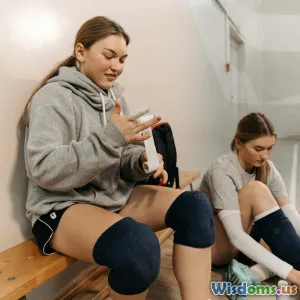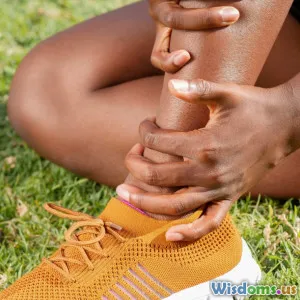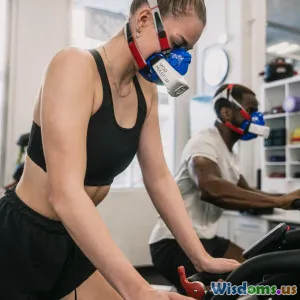
A Deep Dive into Female Athletes and Injury Prevention Strategies
9 min read Explore injury prevention strategies specifically designed for female athletes to enhance performance and longevity in sports. (0 Reviews)
A Deep Dive into Female Athletes and Injury Prevention Strategies
Introduction
Every year, millions of female athletes across amateur and professional levels push their bodies to perform at elite levels. Yet, despite advances in sports science, many still face a disproportionate risk of certain injuries compared to their male counterparts. Understanding why female athletes experience specific injury patterns, and how targeted prevention strategies can help, is essential—not only to safeguard health but to enhance performance and longevity in sport.
This article takes a comprehensive look at the unique physiological factors influencing injuries in female athletes, common injury types, and evidence-based prevention methods rooted in the latest sports science research.
Understanding the Physiological Landscape
Hormonal Influences and Injury Risk
Female athletes' injury risk is partly shaped by hormonal fluctuations, particularly related to estrogen and progesterone levels throughout the menstrual cycle. Research, such as the study published in the American Journal of Sports Medicine (2010), suggests increased anterior cruciate ligament (ACL) injury risks during the ovulation phase when estrogen peaks, affecting ligament laxity and neuromuscular control.
Katie Smith, a veteran physiotherapist specializing in women’s sports medicine, states, “Hormones can subtly alter tissue properties and proprioception, meaning training and prevention programs need to account for cycle phases rather than treating female athletes as static entities.”
Anatomical and Biomechanical Differences
Compared to males, females generally have wider pelvises and increased Q-angles (the angle between the hips and knees), which influence lower limb alignment. This anatomical structure can predispose women to conditions such as patellofemoral pain syndrome or ACL tears due to altered biomechanical stress during dynamic movements like cutting and jumping.
Emerging technologies like 3D motion capture have helped illustrate these differences, leading to refined screening methods. For example, the drop vertical jump test assesses dynamic knee valgus—a known risk factor for ACL injuries—providing actionable data to tailor injury prevention exercises.
Common Injuries Among Female Athletes
ACL Injuries
The ACL tear epidemic among female athletes is well documented; females are up to eight times more likely to suffer ACL injuries in sports like soccer, basketball, and volleyball. These injuries usually occur during non-contact jumping or pivoting movements, highlighting neuromuscular and biomechanical vulnerabilities.
A landmark example is the case of Lindsey Vonn, a world-renowned ski racer who suffered an ACL injury but credited her adherence to targeted neuromuscular training with her subsequent recovery and injury resilience.
Stress Fractures
Due to differences in bone density and menstrual health, female athletes can be more prone to stress fractures, particularly in the lower extremities. The Female Athlete Triad—comprising low energy availability, menstrual dysfunction, and low bone mineral density—remains a key framework in understanding and preventing these overuse injuries.
Patellofemoral Pain Syndrome (PFPS)
PFPS, often termed “runner’s knee,” disproportionately affects female athletes. Weakness in hip abductors and poor neuromuscular control result in maltracking of the kneecap, creating chronic discomfort and limiting athletic participation.
Evidence-Based Injury Prevention Strategies
Neuromuscular Training Programs
One of the most effective injury prevention tools for female athletes is neuromuscular training focusing on improving strength, balance, coordination, and proper landing techniques.
A well-known program, FIFA 11+, used widely in female soccer, integrates plyometrics, balance, core stability, and strength training. This program has demonstrated up to a 50% reduction in ACL injuries in teams that implemented it diligently.
Periodized Training Respecting Hormonal Cycles
Recent scientific advances advocate for cycle-based training where intensity and recovery are modulated according to phases of the menstrual cycle. For instance, during the ovulatory phase, incorporating additional neuromuscular control and proprioceptive exercises may mitigate the increased ligamentous laxity.
Dr. Sarah Tenforde, a Harvard-affiliated sports medicine expert noted, “Integrating hormonal awareness in training regimens is a promising frontier for both injury prevention and optimizing athletic performance.”
Addressing the Female Athlete Triad and RED-S
Ensuring optimal nutrition, energy availability, and hormonal health is fundamental. Regular screening for symptoms indicative of energy deficiency, menstrual irregularities, or bone health is crucial.
Organizations like the American College of Sports Medicine (ACSM) recommend multidisciplinary approaches involving dietitians, physicians, and coaches to manage risks associated with the Female Athlete Triad or Relative Energy Deficiency in Sport (RED-S).
Technique and Equipment Optimization
Proper biomechanics training embedded into sport-specific drills helps female athletes correct faulty movement patterns early. Additionally, suitable footwear and playing surfaces can lessen injury risk—for example, cleats offering adequate lateral support reduce lower limb injuries in soccer.
Real-World Applications and Success Stories
The US Women’s National Soccer Team
The USWNT ranks among the pioneers embracing science-backed injury prevention programs. Their commitment to individualized neuromuscular training, monitoring workloads vigilantly, and employing a robust medical team has contributed to relatively lower injury rates despite intense competition levels.
Collegiate Sports and Injury Prevention Research
Many NCAA programs have integrated comprehensive injury prevention protocols after research highlighted high ACL injury rates in women’s sports. These include pre-season screening, technique coaching, and athlete education, showing significant decreases in time-loss injuries.
Conclusion
Injury prevention in female athletes transcends one-size-fits-all solutions. It demands a nuanced approach acknowledging unique hormonal, anatomical, and biomechanical factors influencing injury risk. By integrating neuromuscular training, respecting menstrual cycles, addressing nutritional needs, and optimizing technique and equipment, female athletes can not only reduce injury rates but also elevate their performance sustainably.
As awareness and research advance, we stand at an exciting threshold—where informed strategies empower female athletes to achieve their best without compromise. The call to action for coaches, trainers, and clinicians is clear: combine the art and science of female-specific injury prevention to foster safer, stronger sporting futures.
References
- Hewett, T.E., et al. (2010). The effect of menstrual cycle phase on ACL injury risk in women. American Journal of Sports Medicine.
- Mandelbaum, B.R., et al. (2005). Effectiveness of neuromuscular training for prevention of ACL injuries in female athletes: Results from a randomized clinical trial. American Journal of Sports Medicine.
- American College of Sports Medicine. (2014). Position Stand on The Female Athlete Triad.
- Fernández-Fernández, J., et al. (2020). Prevention strategies for injuries in female athletes: Evidence and practical applications. Sports Medicine.
This article aims to inform athletes, coaches, and healthcare providers about tailored injury prevention strategies to enhance both competitive longevity and well-being in female sports.
Rate the Post
User Reviews
Popular Posts
















